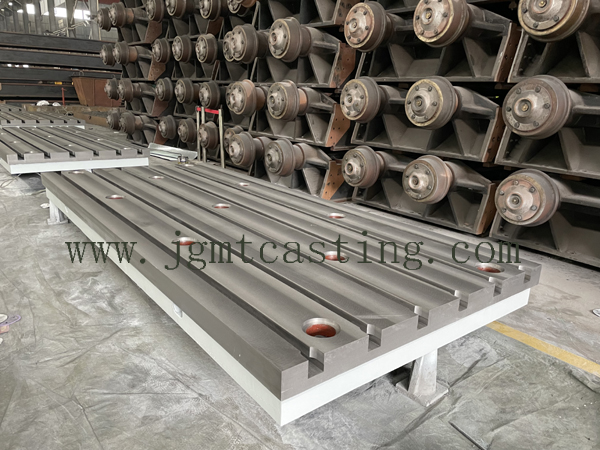When the hardness is insufficient, there will be two manifestations:
1. It shows that the hardness value of the whole workpiece is low.
2. It is manifested as insufficient local hardness or soft spots.

The reasons for the insufficient quenching hardness of T-slot cast iron surface plate castings are as follows:
1. Improper selection of raw materials
Uneven microstructure of raw materials causes insufficient local hardness or soft spots.
One of the following situations occurs in the microstructure: carbide segregation or aggregation, such as ferrite aggregation, graphite, severe Widmanstatten structure, etc., will have insufficient hardness or soft spots.
2. Heating process
(1) The quenching heating temperature is low, and the holding time is insufficient.
For example, gray cast iron 250, when the heating temperature is between Ac3 and Ac1, because ferrite is not dissolved into austenite, after quenching, there is no uniform martensite, but ferrite and martensite will affect the hardness of the workpiece. . Undissolved ferrite can be seen from metallographic analysis. For high-carbon steels, especially high-alloy steels, if heating or holding time is insufficient, pearlite cannot be transformed into austenite, and martensite cannot be obtained. In actual production, the above situation is often due to deviations in the indication of the instrument (indicated temperature is too high) or uneven furnace temperature, which makes the actual temperature of the workpiece lower; the thickness of the workpiece is estimated incorrectly, which causes the holding time to be too short.
(2) The quenching heating temperature is too high and the holding time is too long.
(3) When quenching and heating, the surface of the workpiece is decarburized.
After quenching, the metallographic analysis of HT250 gray cast iron shows that its surface is ferrite and low-carbon martensite. After the surface decarburized layer is removed, the hardness meets the requirements. This situation often occurs in the box furnace without protection Or it is poorly protected, or heated in a salt bath with poor deoxidation, causing oxygen to react with carbon atoms in the workpiece to form CO, which reduces the carbon content on the surface of the workpiece to insufficient surface hardness.
3. Cooling process issues
(1) Improper selection of quenching medium for assembling flat plate.
(2) The influence of quenching medium temperature.
During water quenching, a large number of parts are continuously quenched. If there is no circulating cooling system, the water temperature will rise and the cooling capacity will decrease. There will be a phenomenon that the quenching is not hard. When the oil is cooled, due to the low temperature and poor fluidity of the oil at the beginning of the quenching, the cooling capacity is not strong, resulting in the hardening of the quenching.
(3)The medium is too old during quenching.
When the alkali (salt) bath contains more impurities or the water content is too small, it is easy to produce a quenching soft point.
(4) Improper time control of cooling assembly platform.
When HT250 gray cast iron is used to manufacture and assemble flat plates or parts with large cross-sections, in order to prevent deformation and cracking, water quenching is used. Parts that stay in the water for too short or stay in the air for too long after being taken out of the water are transferred to the oil. Due to the high temperature of the parts themselves, especially the slow cooling rate of the core, uniform martensite cannot be achieved.









